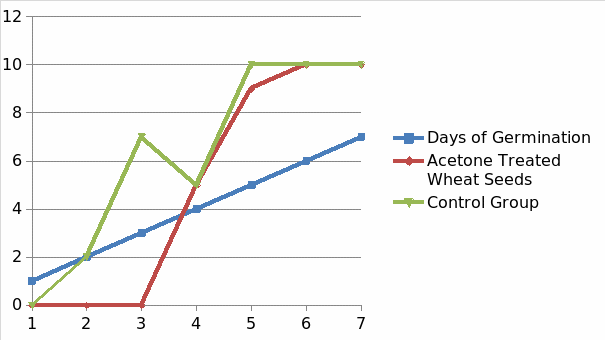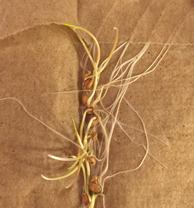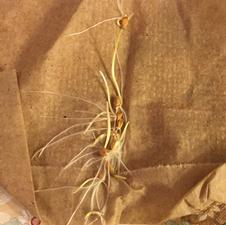Research Title
The experiment was carried out to study the effect of Acetone on the germination of wheat seeds.
Objectives of the Study
As the search for factors that affect seed germination continues, farmers believe that internal and environmental factors influence the growth performance of the seeds. As a result, the study focused on the effect of acetone on the germination of wheat seeds.
Introduction
The sprouting of seedlings from the shoot and root of seeds is called germination. However, the factors that affect seed germination under normal conditions differ with soil type and location. Previous literature revealed that under normal conditions the factors that affect seed germination include moisture, temperature, oxygen, and light (Kannan and Upreti 610). However, seed dormancy is a condition that inhibits germination under normal conditions. As a result, the seed fails to disperse under favorable conditions. Seed dormancy exists in different forms, which include exogenous and endogenous dormancy. Exogenous dormancy includes physical, mechanical, and chemical dormancy. However, endogenous dormancy includes physiological, morphological, and combined dormancy.
Thus, germination is an important phase of a plant cycle. Surveys conducted by plant farmers revealed that environmental factors affect the germination rate of seeds (Qi and Burkholder 503). From the analysis of the previous literature, we can establish the importance of environmental factors on seed germination. However, internal factors that affect seed germination include seed vitality, genotype, seed maturation, and seed dormancy. Seed vitality indicates the ability of seedlings to withstand abnormal conditions. Previous surveys revealed that chemical compounds promote and inhibit seed germination (Gentile and Trematerra 860). As a result, farmers avoid harsh chemicals to mitigate seed dormancy. However, documented reports revealed that herbicides and pesticides affect seed germination. By, implication, the application of chemicals before planting affects seed germination. As a result, the chemical application must be conducted in phases to reduce seed dormancy.
However, chemicals like cytokinins, auxins, gibberellins, abscisic acid, ethylene, and hydrogen peroxide promote seed germination. Consequently, unsaturated lactones, gases, aldehydes, organic acids, aromatic acids, amino acids, and alkaloids inhibit seed germination. Wheat is a protein consumed by 98% of the human population. The plant belongs to the cereal family, which is affected by environmental factors. Previous surveys revealed that wheat seed is susceptible to insect attack (Gentile and Trematerra 860). As a result, over two hundred insect species attack wheat seeds. However, the commercial production of wheat provides food, employment, and money to peasants and agricultural farmers. In an attempt to improve plant yield, researchers conducted studies to examine the influence of plant extracts on seed germination. The survey revealed that most plant extracts stimulated seed development. The research result was consistent with several findings in agricultural articles. Consequently, studies on pest control evaluated the influence of chemicals on seed germination.
The results revealed that soil requirements, environmental factors, and an effective seed dressing before planting mitigate dormancy in wheat seeds. However, most farmers believe that chemicals used for post-harvest storage affect germination. The argument was inconsistent with research findings on most storage chemicals. Acetone is a volatile organic compound that evaporates rapidly. The compound is found in plant tissues, forest combustions, and combustion engines. The gas has a distinct smell and combines freely with atmospheric gases. Previous research on its contribution to agriculture has not been ascertained (Gentile and Trematerra 861). As a result, we cannot argue the effect of acetone on seed germination. Thus, the study will determine the effect of acetone on wheat seed germination. The wheat seed was treated with acetone solution and stored at room temperature.
Stages of Seed Germination
Water is an important variable in germination. However, optimum temperature and oxygen promote germination. The physiology of germination can be summarized in the next section. A viable seed utilizes its mineral for germination. As a result, the plant enzyme acts on carbohydrates and other minerals to provide the energy for germination. As a result, a chemical reaction occurs, which is triggered by osmosis and imbibition. Thus, the seed coat collects water through osmosis to stimulate a catalytic reaction. However, hydrolysis and food transfer facilitate the germination process. The net change in the mass of seed before germination is influenced by aerobic respiration. The overall effect triggers the radicle emergence under normal conditions. Consequently, the plumule that is a visible sign of germination is observed. Thus, the stages of seed germination include water imbibition, water imbibition, and germination. Please note that the germination process is irreversible.
Hypothesis
The research was conducted in a conducive atmosphere to determine the effect of acetone on wheat seed germination. As a result, we considered factors that affect seed germination to prevent experimental error. Thus, the environment was conducive to seed germination. We measured the length of the long and short coleoptile during germination. However, the emergence of leaf stand marked the end of seed germination. We hypothesize that seed treatment with acetone will have a positive response to seed germination. By implication, acetone treatment will stimulate wheat seed germination under normal conditions.
Prediction
I suggested that wheat seed treatment using acetone would promote seed germination. Unlike previous surveys on plant extracts, I believe that acetone treatment will reduce seed dormancy. Consequently, acetone chemicals can be used to treat certain plant pests; therefore, seed treatment with the chemical will promote germination. Thus, we collect measures during the 7-day trial. Measurements were taken for seed length and germination numbers. The experiment has a control group that comprised 9 ml water. The results will be compared to ascertain the effect of acetone on seed germination. The experiment was conducted at room temperature to ascertain the effect of acetone solution on the germination of wheat seeds. Two Ziploc bags were placed at different ends of the experimental area. The Ziploc bag, which contained 10 wheat seeds, was wrapped to protect the seedlings. However, the control group was soaked with distilled water. The acetone solution was transferred using the pipette and the graduated cylinder.
Materials and Methods
The present study was carried out in a biology laboratory under normal conditions. Consequently, the wheat seeds were collected from a reputable agricultural base. As a result, the seeds are viable and can achieve normal germination under favorable conditions. The material for the experiment to determine the effect of acetone on wheat seed germination includes paper towels, control group, distilled water, and paper foils
Materials for the Experiment
- Two Ziploc bags
- Distilled water
- Wheat seeds
- 10 ml of tap water
- Paper towel
- 1 ml of acetone
- Record book
- Graduated cylinder
- Control solution
- Pipette
The experiment was conducted at room temperature to ascertain the effect of acetone solution on the germination of wheat seeds. Two Ziploc bags were placed at different ends of the experimental area. The Ziploc bag, which contained 10 wheat seeds, was wrapped to protect the seedlings. However, the control group was soaked with distilled water. The acetone solution was transferred using the pipette and the graduated cylinder. I transferred 1ml acetone into a solution for seed treatment. Each experiment bag was labeled accordingly to avoid human error. Please note that the acetone solution was poured into the Ziploc bag containing 10 wheat seeds. The bag was sealed and placed in a fume cupboard to avoid contamination and harsh weather conditions. The experiment was observed at intervals to ascertain the mode of germination. The record book was prepared based on the experimental variables. As a result, I adhered to the rules guiding laboratory experiments. The rules guide laboratory experiments were followed. Please note that the environment was clean and ventilated to avoid adverse conditions that affect germination.
The acetone solution was labeled to avoid human error. I wore laboratory protective clothing to avoid a chemical spill. The experiment was observed for seven days to determine the effects of water and acetone solution on seed germination. Consequently, records of daily readings were observed repeatedly to avoid parallax error. I also checked the room temperature daily to avoid unfavorable laboratory conditions. However, during germination, the length of the long and short coleoptile was recorded. Consequently, the first day of germination was recorded for both experiments. Please note that the leaf emergence signaled the end of the germination phase.
Results
Table 1: Germination rate per days.
Discussion
The results revealed seed germination in both Ziploc bags. Table 1 showed the stages of germination for each Ziploc bag. From the analysis, the acetone-treated seed did not germinate within the first three days. By implication, acetone inhibited the growth sequence of the wheat seeds. Another observation from the experiment is the permeability of wheat seeds. The treated wheat seed required more time to allow seed coat osmosis. However, the control group on the second day. A noticeable change occurred in a fifth of planting. Five seeds each germinated in the Ziploc bags. The results revealed that the acetone-treated seed overcame the effects of acetone on the fourth day. Consequently, the results showed the negative response of acetone to wheat seed germination. The control group germinated on the second day of planting, which is consistent with the results of previous literature (Gentile and Trematerra 868). Consequently, the germination process reached its climax on the seventh day. The result revealed that 10 seeds each germinated in both Ziploc bags. The noticeable germination process revealed the significant effect of acetone solution on wheat seed germination.
Table 2 revealed the distribution of acetone and control wheat seeds during the experiment. The results revealed that the wheat seeds in the control solution reached their highest germination rate on day five. However, the acetone-treated seeds reached their germination rate on day six. The disparity in germination rate indicated the effect of acetone on wheat seed germination. Table 3 revealed the graphical representation of the germination rate. Pictures 1 and 2 showed the germination rate at two different days of planting.


Conclusion
We will reject the hypothesis that acetone promotes seed germination. The results revealed the effect of acetone on wheat seed germination. The result is in agreement with the findings of previous literatures on the seed germination.


Works Cited
Gentile, Persi and Trematerra, pezi. “Insect pests of hulled wheat and ecology of Sitotroga cerealella.” Technica Motitoria 68.11 (2013): 855-862. Print.
Kannan, Aambrose and Upreti, Raj. “Influence of distillery effluent on germination and growth of mung bean (vigna radiata) seeds.” Journal of Hazardous Materials 158.4 (2014). 609-615. Print.
Qi, Tasi and Burkholder, Wentworth. “Protection of stored wheat from the granary weevil by vegetable oils.” J. Econ. Entomol. 85.4 (2012): 502-505. Print.